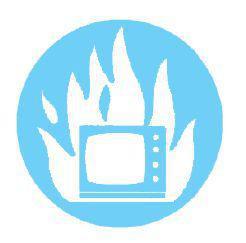SAS Urban Survival Handbook (22 page)
Read SAS Urban Survival Handbook Online
Authors: John Wiseman
Tags: #Health & Fitness, #Reference, #Survival, #Fiction, #Safety, #Self-Help, #Personal & Practical Guides, #General, #Survival Skills

Fix stops on the inside of drawers to prevent them being pulled out too far and spilling their contents.
Get into the habit of ALWAYS shutting cupboard doors. Standing up from stooping or turning round, it is easy to catch against the door or knock your head against the bottom edge—a nasty injury if it is metal!
Knives
Never put sharp knives into washing-up water with other items. It is easy to touch or grasp a blade unintentionally. Handle each knife individually. Wash, wipe and put away, in a childproof place—not ‘on display’ where children (or even intruders!) may misuse them.
Pass knives with care! Hold the blade with the cutting edge AWAY from the palm or fingers and offer the handle to the other person. DON’T walk about holding a knife.
ALWAYS cut away from yourself. A sharp knife cuts smoothly and is therefore less likely to inflict injury than a blunt one (which has to be used with more pressure so cannot be halted as quickly).
NEVER use knives, or other cutlery, for tightening screws, removing bicycle tyres or other jobs. It will not only damage blades, but produce burrs which could cause cuts if they catch against the hand or lips in normal use.
Sharpening a knife consists of wearing away some of the metal to produce a thin cutting edge. The traditional method is to hone it on a whetstone and then finish the edge on a sharpening steel—a grooved metal rod. These techniques require practice to do them safely and efficiently.
There are several other kinds of sharpener, some electricallypowered, which offer metal discs, small steels, tungsten cutters or ceramic grinders to remove metal from both sides of the blade at once. In all cases, they operate by drawing the knife between the cutters. If they are easy to keep stable, they are probably safer than a steel.
Accidents in sharpening knives usually occur when the sharpening device slips—not the knife, so choose the one you feel is solid and stable.
Some individual knives also come with their own holster, which not only, protects the blade when not in use but sharpens it each time it is drawn in and out. They only sharpen that knife and cannot be used on others unless they exactly fit the holster.
Wash knives before sharpening—and afterwards clean both knife and sharpener to remove the small particles of metal which will still be attached to them.
REMEMBER
It is well worth investing in a few good basic knives, instead of lots of gadgety ones. Good knives are usually of better steel, and honed to a longer-lasting edge. Sometimes, good kitchen equipment shops may be able to recommend specialist companies who re-sharpen good knives when the edge needs major work. Treat these good knives with care, and they could last for years.
LIVING ROOM
 The majority of living room accidents involve tripping over something—so ensure there are no trailing cables from lamps and electrical appliances, or small obstructions. Never leave things lying around on the floor. Teach children not to leave toys scattered about where they or others could trip over them.
The majority of living room accidents involve tripping over something—so ensure there are no trailing cables from lamps and electrical appliances, or small obstructions. Never leave things lying around on the floor. Teach children not to leave toys scattered about where they or others could trip over them.
The living room is the area where there is most likely to be an open fire, a gas fire or an electric heater—whether or not the house is centrally heated. Do not leave newspapers or fuel close to open fires.
Fit a fireguard
A sparkguard, consisting of a screen of fine wire mesh, should be placed round an open fire, whenever it is left unattended and especially when you go out of the house or up to bed. An even better practice would be to rake the embers so that the fire goes out completely. The guard should be anchored to the wall, and enclosed at the top, sides and front—if all sparks are to be safely contained.
CHILDPROOFING
For a home with young children, a secure fireguard fixed to the wall is needed with any sort of fire—not just an open one. Children must not only be kept away, but also prevented from poking things through into the flames or onto the electric element. An open mesh will allow you to enjoy the full benefit of the fire, but closer mesh is needed for an efficient sparkguard.
Keep alcohol away from youngsters—do not leave drinks out on a table and always return the bottle to a secure cupboard or cabinet, which should be locked before you leave the room. NEVER keep children’s drinks in the same place as alcohol—don’t tempt them to help themselves.

WARNING
NEVER use fireguards for airing or drying clothes, nor hang things to dry above the grate. ENSURE that portable oil and gas heaters are on a stable base and out of draughts. Follow the instructions already given. Never cover the ventilation grills of these or of any electric fires. DON’T use an overmantel mirror for brushing hair, shaving or applying make-up. It is easy to get too close and, if wearing loose clothes, to set yourself alight.
Other fire hazards
Upholstered furniture often burns easily and foam, plastic and synthetic fabrics produce thick smoke and toxic gases. Modern furniture should be fire resistant and tested to withstand a smouldering cigarette—and labelled so. Look for items that have also been tested as resistant to a lighted match.
Candles
can create a very cosy and romantic atmosphere, but use them with caution. People who are used to lighting their homes with oil lamps and candles know how much heat is generated above them. Pass your hand above a naked candle flame and you will realize how carefully it must be placed so that it cannot ignite anything overhead or nearby. Always set candles securely in holders with a firm base.
NEVER put lighted candles on top of a television set.
Cigarettes
not only damage your health, they are a serious fire risk. Make sure all ashtrays are stable—the lidded kind that extinguish cigarettes are best. Do not put sweet papers in them—they could ignite. Never balance ashtrays on the arms of chairs or place them in the middle of a sofa seat. A fallen cigarette end could start a fire.
NEVER smoke in bed! However many times this advice is repeated, people still do it and start serious fires.
FIRE FACTS
Some furnishings burn at a temperature of over 1000°C (1832°F), and produce deadly choking fumes and smoke. In some cases a whole house has been engulfed in under TWO MINUTES (see FIRE!).
Over twice as many people are asphyxiated by fumes and smoke, than are killed by the flames. Keeping low to the floor as you escape, covering your mouth and nose, will help protect you from the worst effects. Apart from the smoke, heat and carbon monoxide dangers—polyurethane foam gives off hydrogen cyanide when burnt. PVC gives off hydrogen chloride. Both are highly toxic. Note that some foam furnishings may still be made of polyurethane foam. PVC is very common—even electrical cables are insulated with it—and any appliance, especially a television, contains enough PVC to give off a roomful of fumes.
If a fire gets out of control—EVACUATE. Call the fire brigade.
Television sets/computer screens
ALL electrical equipment should be given plenty of ventilation. Don’t block the air vents provided in the appliance.
Televisions involve many hazards. They operate using very high voltages—at least 20,000 volts for colour, 10,000 volts for black-and-white. Their circuits take the main voltage and amplify it. These high voltages are still present for a while after the television has been switched off. NEVER take the back off the set, or poke anything through the holes. NEVER place fish tanks, flower vases, potted plants, drinks or any other liquids on top of or close to televisions. The danger of electrocution is very real and very serious.
TV/computer fires
Because of fire risks, televisions should be switched off at the mains and unplugged when not in use—not left on ‘standby’, which is possible with some sets.
If you smell burning
, or if you see smoke or flames, switch off at the mains immediately. If the TV is blocking your route to the socket, switch off at the fuse box/consumer unit.
Use only a dry extinguisher or fire blanket—NEVER liquid extinguishers. A damp blanket (when the power is off) covering the entire set should contain flames and some fumes—it may also help contain glass fragments in case the tube ‘explodes’ (actually implodes). Do NOT approach the set from the front, because of the danger of flying glass fragments.
Evacuate because of the risk of highly toxic fumes, and ventilate the room as soon as the fire is fully extinguished. If there is any sign of the fire getting out of control, evacuate and call the fire brigade.

EMERGENCY!
TV/VDU FIRE
- ▶
Switch off at the mains socket
OR
- ▶
Switch off at fuse box/consumer unit
DO NOT STAND IN FRONT OF THE SCREEN—THE TUBE MAY EXPLODE
USE A DRY EXTINGUISHER AIMED INTO THE TV/VDU
OR
COVER THE TV/VDU WITH A FIRE BLANKET
OR
COVER WITH A DAMP BLANKET/TOWEL (SWITCH OFF POWER)
EVACUATE
Because of the risk of toxic fumes
IF THE FIRE GETS OUT OF CONTROL
Evacuate and call the fire brigade
Children’s toys
Check all toys for sharp edges, finger traps or pieces which could be swallowed. Look especially for eyes on spikes in old soft toys. Do not let small children play with anything small enough to become lodged in nose, ear or throat.
Lead paint was regularly used on old toys and young children should not be allowed to play with them, since they might put them in their mouths or suck fingers which have picked up flakes of paint.
All toys for sale in shops have to pass stringent safety tests. This is particularly important with toys for young children. Beware cheap imported toys (often seen in markets) which may evade the testing procedures.
Allow children to use only non-toxic paints and crayons—make sure they are so labelled. Many artists’ colours contain poisonous chemicals which could be sucked from brush or hands (see DIY/CRAFT HAZARDS: Artists’ paints).
KEEP TOYS TIDY! Make sure children have a cupboard or box in which to keep their toys and a shelf for their own books. Toys left lying around are a common cause of falls—especially on stairs. Small round objects and wheeled toys are most dangerous, but anything lying on the stairs could send you headlong down them.
BEDROOM